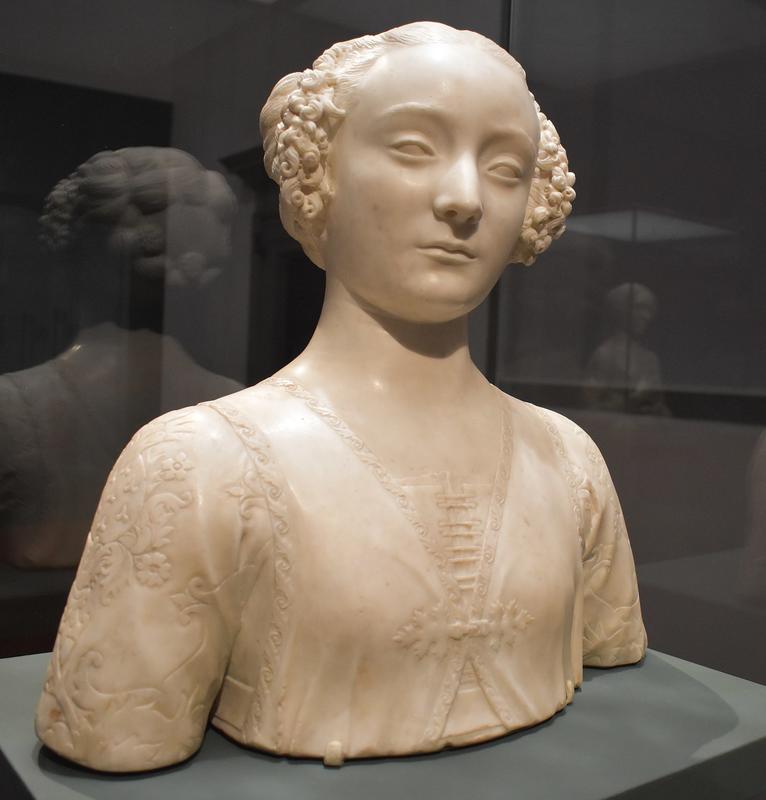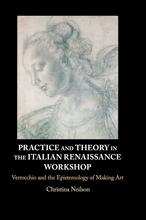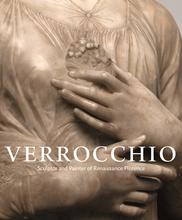More about Bust of a Woman
- All
- Info
- Shop

Sr. Contributor
You may have heard the expression, “she wears her heart on her sleeve,” but the mystery lady in Andrea Verrocchio’s Bust of a Woman appears to be wearing testicles on her sleeves, which may offer a titillating clue to her identity.
The sitter’s true identity remains unknown, but in addition to her peculiar fashion choice, she might not have been long for this world. Two of the principal identities proposed were both tragic Renaissance maidens who perished in early youth.
One is Albiera degli Albizzi, who died at the the tender age of 15 before she could wed her adoring fiance, Sigismondo della Stufa. She was infected with a fever at a ball celebrating the marriage of Princess Eleonora of Naples to the Duke of Ferrara (later parents-in-law to Lucrezia Borgia). Coincidentally, a bust of Elonora’s sister Beatrice stands next to Bust of a Woman in the Frick Collection. Also attending the ball was the famed Simonetta Vespucci, a fellow Florentine beauty who died young and the reputed muse of Botticelli. Albiera, Eleonora and Simonetta have been described as “The three Graces of the ball.” Renaissance poet Angelo Poliziano wrote that Albiera’s beauty on the occasion was so sublime that the vindictive goddess Rhamnusia (a.k.a. Nemesis) afflicted her with the fatal fever out of jealousy.
Sigismondo was so grief stricken by his future bride’s death that he commissioned an anthology of poetry memorializing her, notably the aforementioned elegy by Poliziano, and another by Alessandro Braccesi praising a posthumous bust of Albiera by a mysterious artist called “Morandus.” The Morandus bust seems lost to time, but this volume of poetry marks the earliest record of a Renaissance bust of a girl. Recent scholarship has proposed Bust of a Woman as a possible match. This could be bolstered by the observation that while this portrait is exquisite from the front, it reads rather stiffly in profile, suggesting it may be one of Verrocchio’s earliest (and therefore less practiced) works.
Another theory spawns from what appear to be seven pairs of testicles on each of her richly brocaded sleeves, heraldic devices that suggest a possible connection to renowned mercenary Bartolomeo Colleoni. The name “Colleoni” derives from the Latin word for testicles and is similar to the vulgar Italian for balls. Bortolomeo prided himself on this to such an extent that his coat of arms features three sets of them, supposedly a reference to his own legendary third testicle from an unsubstantiated physical anomaly.
Extra testicle or not, Colleoni had no trouble procreating, siring multiple daughters both legitimately and otherwise. Colleoni was also a great patron of Verrocchio, so Bust of a Woman could depict one of these daughters, perhaps his beloved Medea, who shared a similar fate to Albiera degli Albizzi. Medea also died in the flower of her youth, but was immortalized in a gorgeously sculpted marble tomb in the Colleoni mausoleum. Incidentally, the gate of this monument is emblazoned with the Colleoni testicles, which passersby rub for good luck.
Detractors of the Colleoni hypothesis point out that the motif on the sleeves in Bust of a Woman includes seven sets of alleged testicles, while the coat of arms sports the iconic three. What’s more, the scrotums on the coat of arms curve outward at a three-quarter angle, whereas those on this girl’s dress appear from a flat, full-frontal view (it’s all very academic). Furthermore, similar motifs appear broadly across luxury textiles of the period, so it may not be testicular in nature at all, nor linked to a single noble household. However, supporters contend that the celebrated Colleoni cojones come in various shapes and sizes depending on the depiction, and heraldic references in Renaissance clothing are symbolic allusions rather than literal representations. In a nutshell, while the seven pairs of presumptive testicles on this girl’s shoulders don’t positively identify her as a Colleoni, they certainly don’t rule it out, either. On a less bawdy art historical note, the intricate and detailed rendering of the fabric demonstrates Verrocchio’s early training as a crafter of gold ornaments.
While we cannot be sure that the lovely sitter for Bust of a Woman was either Albiera degli Albizzi or Medea Colleoni, we can be certain that she was not Ginevra de’ Benci, despite the gilded base identifying her as such. She may bear a passing resemblance to the titular subject of the only painting by Leonardo da Vinci publicly displayed in the Western Hemisphere, and da Vinci did after all study under Verrocchio; but the inscription on the base was added after John D. Rockefeller, Jr. acquired the bust from the collection of the late Gustave Dreyfus in 1930. The association with Ginevra stemmed partly from their similar hairstyles, which may in turn cast doubt on the belief this is one of Verrocchio’s earliest busts, as the coiffure was more fashionable later in the artist’s career.
Helen Clay Frick had originally hoped to purchase the Dreyfus estate in bulk, but when the trustees of the Frick Collection denied the acquisition, Rockefeller separately purchased several pieces from the inventory, including this one. He later bequeathed the bust to the Frick Collection following his death in 1960, but by that time Helen opposed the acquisition, presumably fearing such a high-profile bequest from a celebrity billionaire would overshadow her father’s legacy. Thus, Bust of a Woman was loaned out to Princeton for over 25 years out of respect for Helen’s wishes, not appearing in the Frick Collection until 1986, after her death; a fittingly circuitous route to immortality for such an elusive sculpture.
Sources
- Caruso, Francesco. “Philology as Thanatology: a study on Angelo Poliziano’s intellectual biography.” PhD diss., Baltimore, Maryland, 2013. https://docs.google.com/document/d/14lAGPQRN7GBiZs6UJBCaMcHtChs-_1BAAoK….
- Cortesi, Max. “Capella Colleoni.” Atlus Obscura, August 26, 2021. https://www.atlasobscura.com/places/cappella-colleoni.
- Dalvit, Giulio. “Cocktails with a Curator: Verrocchio’s ‘Bust of a Woman’.” YouTube video, 15:20-40. Posted by “The Frick Collection,” July 9, 2021. https://www.youtube.com/watch?v=hBWctv_Ox9M&t=951s.
- The Frick Collection. “Beatrice of Aragon.” Art. Accessed June 8, 2022. https://collections.frick.org/objects/108/beatrice-of-aragon.
- The Frick Collection. “Bust of a Woman: Audio.” Art. Accessed June 8, 2022. https://collections.frick.org/objects/109/bust-of-a-young-woman#showAud….
- Luchs, Alison Luchs. “Verrocchio and the Bust of Albiera degli Albizzi: Portraits, Poetry and Commemoration.” Artibus et Historiae 33, 66 ( 2012): 75 - 97. https://inpress.lib.uiowa.edu/feminae/DetailsPage.aspx?Feminae_ID=32494.
- Rubin, Patricia Lee. The Renaissance Portrait: From Donatello to Bellini. New Haven and London: Yale University Press, 2011. https://books.google.com/books?id=iPP55b2Fk60C&dq=bust+of+a+woman+verro….
- Theroux, Alexander. “Eternal Goddess.” Chicago Tribune, July 16, 1988. https://www.chicagotribune.com/news/ct-xpm-1988-07-17-8801160119-story….













